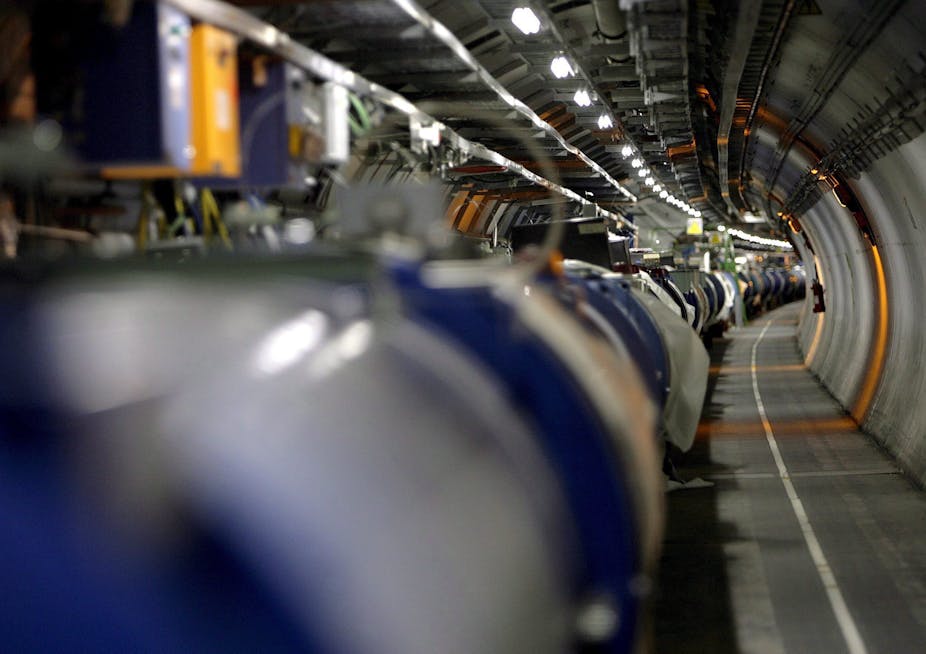Physicists this afternoon announced they have found evidence for a particle considered the biggest missing piece in the standard model of matter, in what is one of the most significant scientific developments in decades.
The elusive Higgs boson, also known as the “God particle”, is thought to give mass to all fundamental particles in the universe. Physicists have spent half a century looking for it. Today in Switzerland two teams of researchers said they had independently found overwhelming preliminary evidence that it exists.
“This is indeed a new particle. We know it must be a boson and it’s the heaviest boson ever found,” said a spokesman for the CMS team, Joe Incandela. “The implications are very significant and it is precisely for this reason that we must be extremely diligent in all of our studies and cross-checks.”
The two teams - CMS and ATLAS - based their findings on separate experiments at the world’s biggest atom smasher, the Large Hadron Collider, at the CERN laboratory near Geneva in Switzerland. They announced the results at a joint scientific seminar in Geneva and Melbourne, which is hosting the International Conference on High Energy Physics.
Speculation was rife before the announcement. In a video that was apparently uploaded to the internet by accident before being pulled, Mr Incandela, from CMS, declared: “We’ve observed a new particle”. He was careful, however, to stress that further observations would be needed before scientists could say they had “discovered” the Higgs boson, named after theoretical physicist Peter Higgs.
Physicists working on the ATLAS team recorded hints of the particle last year. In the latest results, a signal was seen in the decay of a Higgs-like particle into two high-energy photons. The data contained a significant excess of collision events at a mass of around 125-126 gigaelectronvolts, the ATLAS team said. That is the same value suggested by last year’s data.
Researchers describe results on a scale of standard deviation, where a level of 5 sigma means there is 0.00003% probability that the result is due to chance.
“We observe in our data clear signs of a new particle, at the level of 5 sigma, in the mass region around 126 GeV,” said ATLAS experiment spokesperson Fabiola Gianotti. “The outstanding performance of … ATLAS and the huge efforts of many people have brought us to this exciting stage, but a little more time is needed to prepare these results for publication.”
Mr Incandela, from CMS, agreed that the results were preliminary but said “the 5 sigma signal at around 125 GeV we’re seeing is dramatic”.
Yesterday, scientists at America’s top particle-physics facility, Fermilab, claimed they have also found strong evidence for the existence of the Higgs boson — in advance of today’s announcement.
The results provide the “strongest indication to date for the long-sought Higgs particle”, they said.
Jonathan Carroll, a Post Doctoral Research Associate in the Centre for the Subatomic Structure of Matter at the University of Adelaide, said the timing of the announcement was no coincidence. “It’s starting to look like there might have been a signal there, because the result at CERN would have been at least partly visible to the team doing the Tevatron experiment at Fermilab.
"But they’ve been putting out announcements for the past two years, because they’ve been shutting down Tevatron, so they want as much publicity as they can get, and now’s the time to get it.”
CERN Director General Rolf Heuer said the discovery by the ATLAS and CMS teams was “a milestone in our understanding of nature. The discovery of a particle consistent with the Higgs boson opens the way to more detailed studies, requiring larger statistics, which will pin down the new particle’s properties, and is likely to shed light on other mysteries of our universe.”
The European Organisation for Nuclear Research said the next step would be to determine the precise nature of the particle and its significance for our understanding of the universe. “Are its properties as expected for the long-sought Higgs boson, the final missing ingredient in the standard model of particle physics? Or is it something more exotic?
"The standard model describes the fundamental particles from which we, and every visible thing in the universe, are made, and the forces acting between them. All the matter that we can see, however, appears to be no more than about 4% of the total. A more exotic version of the Higgs particle could be a bridge to understanding the 96% of the universe that remains obscure.”

